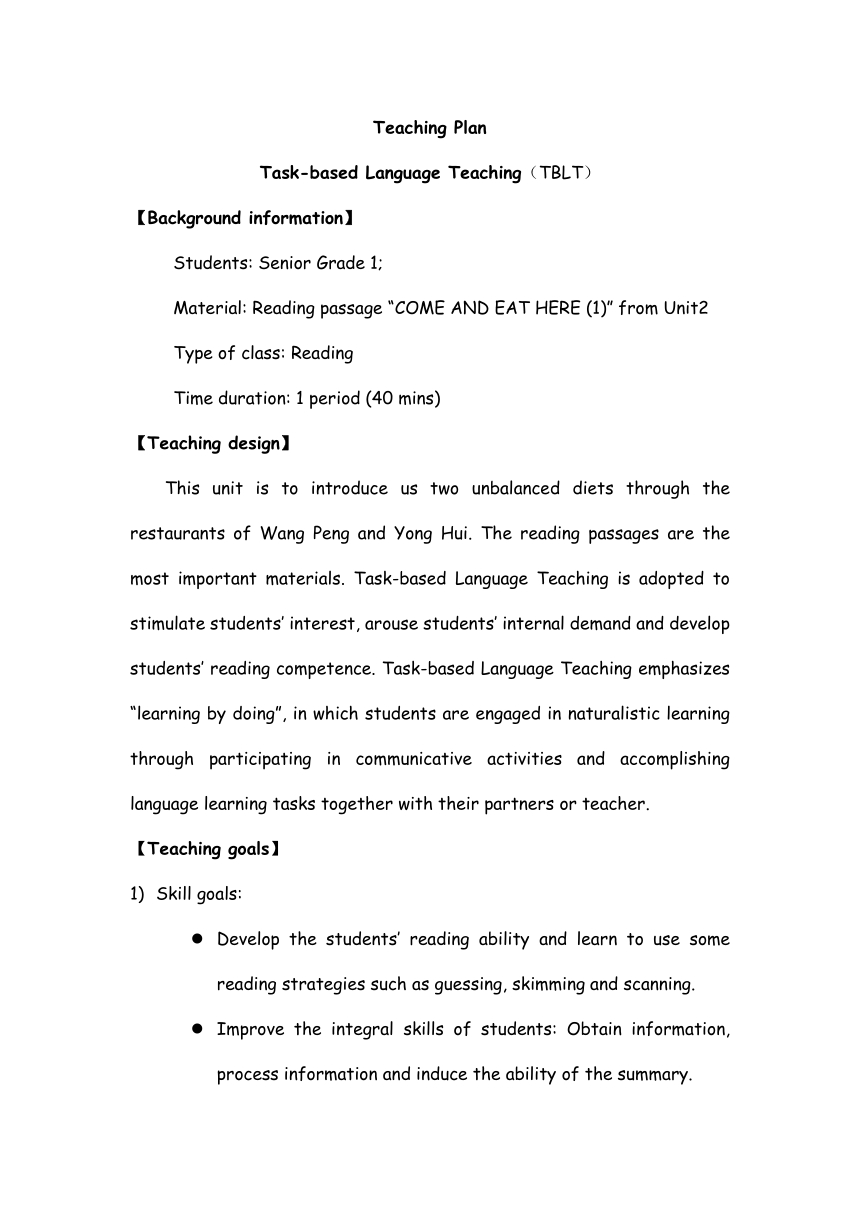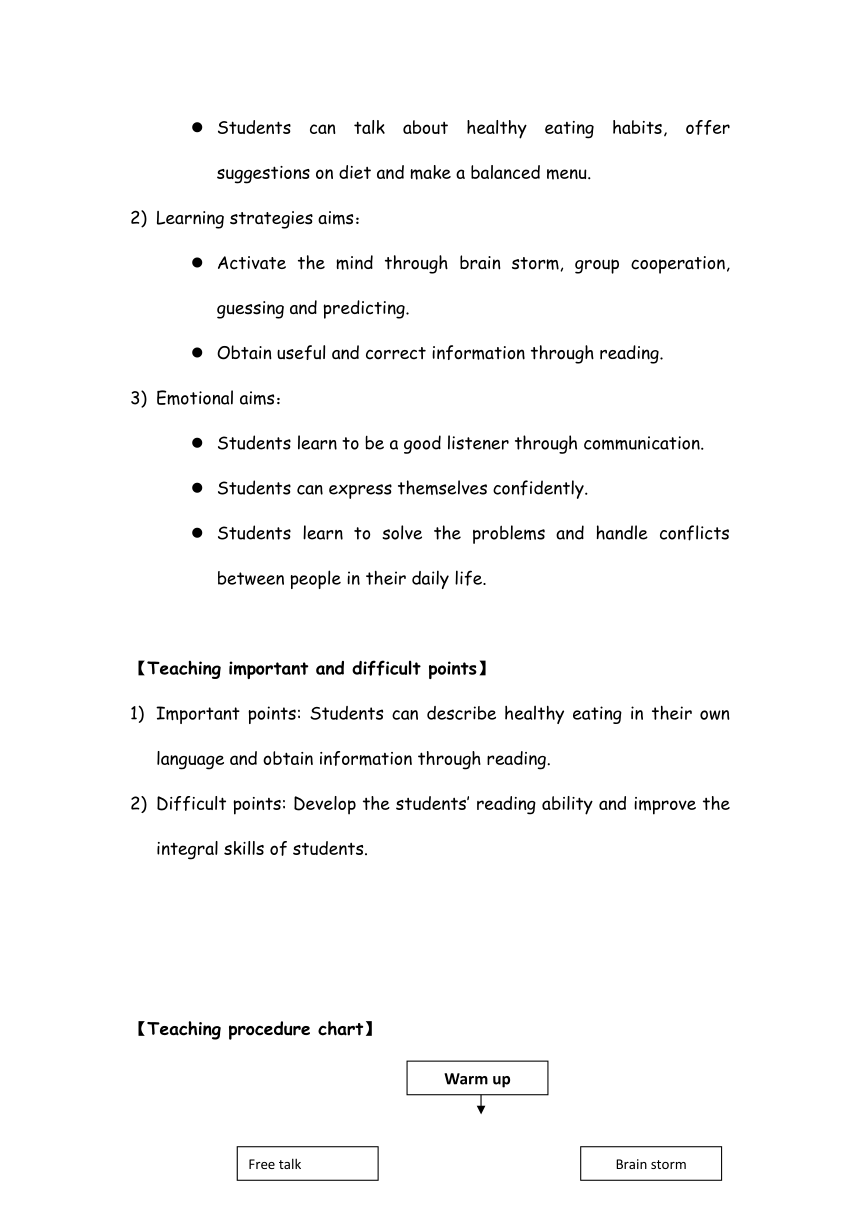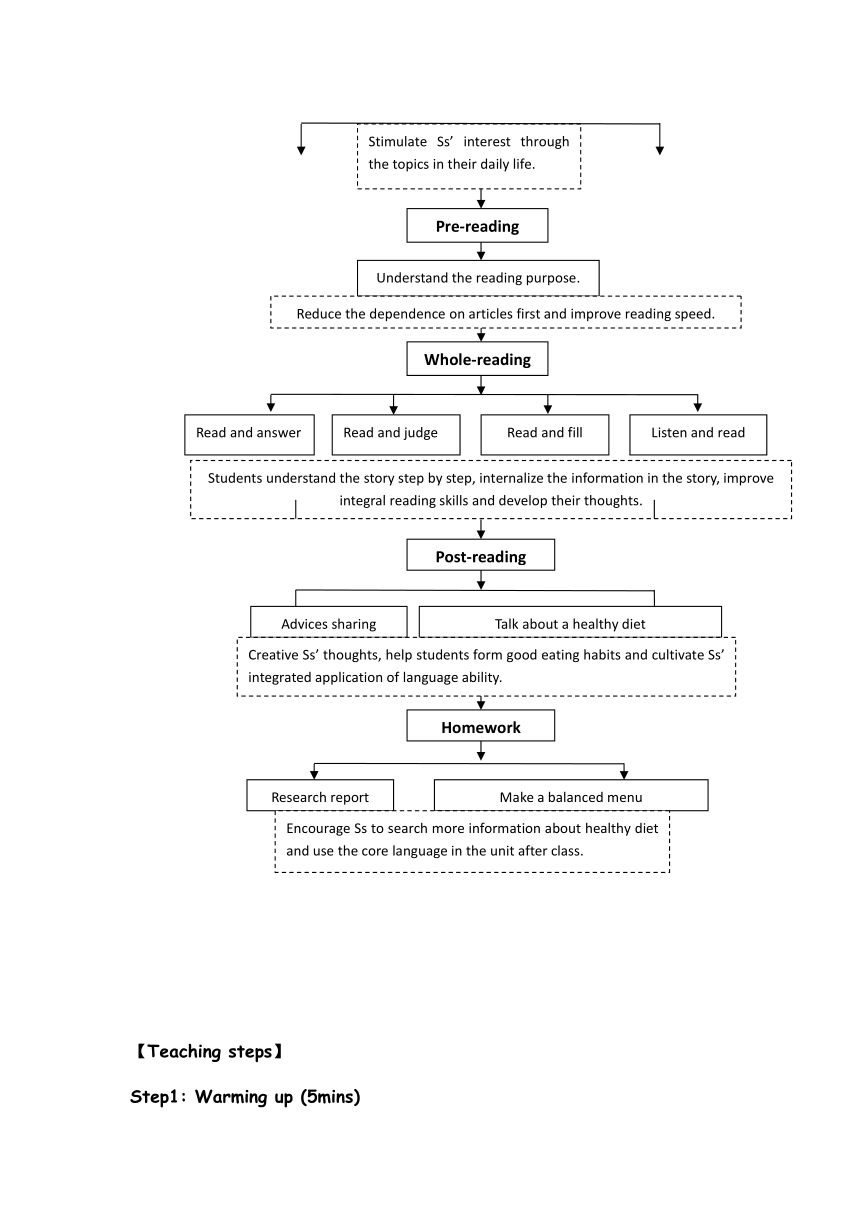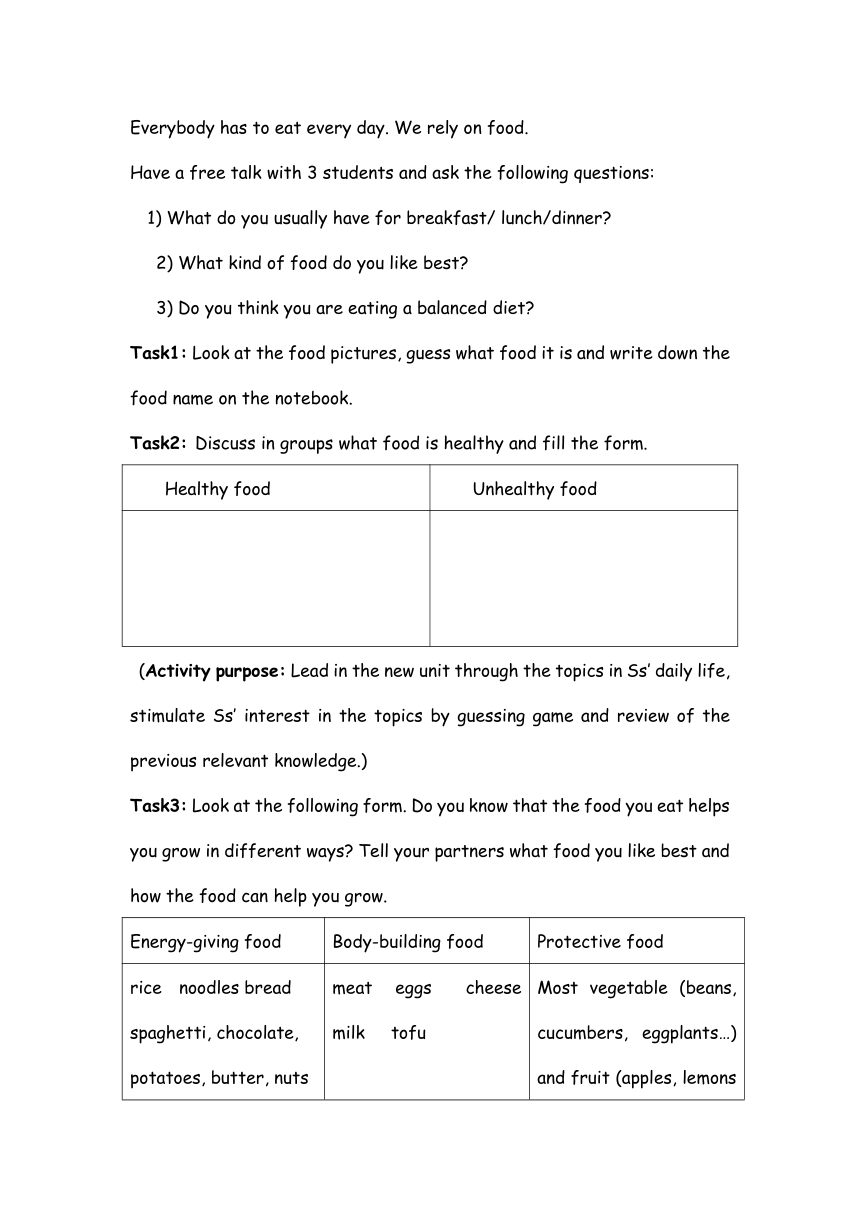2020-2021学年人教版高中英语必修三Unit 2 Healthy eating Reading 教案
文档属性
| 名称 | 2020-2021学年人教版高中英语必修三Unit 2 Healthy eating Reading 教案 |  | |
| 格式 | zip | ||
| 文件大小 | 25.6KB | ||
| 资源类型 | 教案 | ||
| 版本资源 | 人教版(新课程标准) | ||
| 科目 | 英语 | ||
| 更新时间 | 2021-07-14 16:56:28 | ||
图片预览




文档简介
Teaching
Plan
Task-based
Language
Teaching(TBLT)
【Background
information】
Students:
Senior
Grade
1;
Material:
Reading
passage
“COME
AND
EAT
HERE
(1)”
from
Unit2
Type
of
class:
Reading
Time
duration:
1
period
(40
mins)
【Teaching
design】
This
unit
is
to
introduce
us
two
unbalanced
diets
through
the
restaurants
of
Wang
Peng
and
Yong
Hui.
The
reading
passages
are
the
most
important
materials.
Task-based
Language
Teaching
is
adopted
to
stimulate
students’
interest,
arouse
students’
internal
demand
and
develop
students’
reading
competence.
Task-based
Language
Teaching
emphasizes
“learning
by
doing”,
in
which
students
are
engaged
in
naturalistic
learning
through
participating
in
communicative
activities
and
accomplishing
language
learning
tasks
together
with
their
partners
or
teacher.
【Teaching
goals】
Skill
goals:
Develop
the
students’
reading
ability
and
learn
to
use
some
reading
strategies
such
as
guessing,
skimming
and
scanning.
Improve
the
integral
skills
of
students:
Obtain
information,
process
information
and
induce
the
ability
of
the
summary.
Students
can
talk
about
healthy
eating
habits,
offer
suggestions
on
diet
and
make
a
balanced
menu.
Learning
strategies
aims:
Activate
the
mind
through
brain
storm,
group
cooperation,
guessing
and
predicting.
Obtain
useful
and
correct
information
through
reading.
Emotional
aims:
Students
learn
to
be
a
good
listener
through
communication.
Students
can
express
themselves
confidently.
Students
learn
to
solve
the
problems
and
handle
conflicts
between
people
in
their
daily
life.
【Teaching
important
and
difficult
points】
Important
points:
Students
can
describe
healthy
eating
in
their
own
language
and
obtain
information
through
reading.
Difficult
points:
Develop
the
students’
reading
ability
and
improve
the
integral
skills
of
students.
【Teaching
procedure
chart】
(
W
arm
up
)
(
Brain
storm
)
(
Free
talk
)
(
S
timulate
Ss
’
interest
through
the
topics
in
their
daily
life.
)
(
Pre-reading
)
(
U
nderstand
the
reading
purpose.
)
(
R
educe
the
dependence
on
articles
first
and
improve
reading
speed.
)
(
Whole-reading
)
(
Listen
and
read
)
(
Read
and
answer
)
(
R
ead
and
fill
)
(
R
ead
and
judge
)
(
S
tudents
understand
the
story
step
by
step,
internalize
the
information
in
the
story,
improve
integral
reading
skills
and
develop
their
thoughts.
)
(
R
esearch
report
)
(
M
ake
a
balanced
menu
)
(
Post-reading
)
(
Homework
)
(
T
alk
about
a
healthy
diet
)
(
A
dvices
sharing
)
(
C
reative
Ss
’
thoughts,
help
students
form
good
eating
habits
and
cultivate
Ss
’
integrated
application
of
language
ability.
)
(
E
ncourage
Ss
to
search
more
information
about
healthy
diet
and
use
the
core
language
in
the
unit
after
class.
)
【Teaching
steps】
Step1:
Warming
up
(5mins)
Everybody
has
to
eat
every
day.
We
rely
on
food.
Have
a
free
talk
with
3
students
and
ask
the
following
questions:
1)
What
do
you
usually
have
for
breakfast/
lunch/dinner?
2)
What
kind
of
food
do
you
like
best?
3)
Do
you
think
you
are
eating
a
balanced
diet?
Task1:
Look
at
the
food
pictures,
guess
what
food
it
is
and
write
down
the
food
name
on
the
notebook.
Task2:
Discuss
in
groups
what
food
is
healthy
and
fill
the
form.
Healthy
food
Unhealthy
food
(Activity
purpose:
Lead
in
the
new
unit
through
the
topics
in
Ss’
daily
life,
stimulate
Ss’
interest
in
the
topics
by
guessing
game
and
review
of
the
previous
relevant
knowledge.)
Task3:
Look
at
the
following
form.
Do
you
know
that
the
food
you
eat
helps
you
grow
in
different
ways?
Tell
your
partners
what
food
you
like
best
and
how
the
food
can
help
you
grow.
Energy-giving
food
Body-building
food
Protective
food
rice
noodles
bread
spaghetti,
chocolate,
potatoes,
butter,
nuts
meat
eggs
cheese
milk
tofu
Most
vegetable
(beans,
cucumbers,
eggplants…)
and
fruit
(apples,
lemons
peaches,
watermelons…)
(Activity
purpose:
Students
learn
about
three
ways
that
food
helps
us.
Students
judge
whether
they
have
a
healthy
diet
in
their
daily
life.)
Step2:
Pre-reading
(5mins)
Show
some
pictures
and
ask
3~5
students:
1)
What’s
a
balanced
and
healthy
diet?
(A
balanced
diet
should
contain
proper
energy-giving
food,
body-building
food
and
protective
food
so
that
we
can
keep
both
healthy
and
slim.)
2)
What
will
happen
if
we
don’t
eat
a
balanced
diet?
(We
may
get
high
fat,
high
blood
pressure,
heart
disease
or
too
skinny)
Task1:
Look
at
the
title
of
the
reading
passage
COME
AND
EAT
HERE
(1)
and
pictures.
Predict
what
the
passage
is
about
and
share
with
your
partner.
Task2:
Read
the
passage
quickly
to
see
if
you
were
right
and
answer
two
questions:
(fast
reading)
1)
Who
are
mentioned
in
the
story?
(Wang
Peng,
Yong
Hui
and
Lichang)
2)
Where
did
the
story
happen?
(It
happened
in
two
restaurants:
Wang
Peng’s
restaurant
and
Yong
Hui’s
restaurant)
(Activity
purpose:
Weaken
the
difficulty
fist,
reduce
dependence
on
articles
and
help
students
clearly
understand
the
reading
purpose,
form
the
feeling
in
advance
and
improve
their
reading
speed)
Step3:
While-reading
(20
mins)
(intensive
reading)
Task1:
Read
the
passage
carefully
this
time,
try
to
understand
the
main
idea
of
each
paragraph
and
choose
best
answer
to
each
questions:
1)
What
did
Wang
Peng
think
of
the
food
in
his
restaurant?
A.
Very
bad.
B.
Just
so-so.
C.
Unpopular.
D.
Popular.
(D)
2)
What
did
Wang
Peng
do
after
he
saw
his
friend
Li
Chang
hurrying
by?
A.
He
just
sat
in
his
restaurant
felling
frustrated.
B.
He
did
some
research.
C.
He
followed
Li
Chang
to
see
why
he
didn’t
eat
with
him.
D.
He
began
to
advertise
his
food.
(B)
3)
Which
of
the
following
was
not
mentioned
on
Yong
Hui’s
menu?
A.
apples
B.
Cola
C.
Water
D.
Cabbages
(B)
4)
Which
of
the
following
did
Wang
Peng
not
do
to
win
his
customers
back?
A.
He
improved
his
food.
B.
He
advertised
his
food.
C.
He
did
some
research.
D.
He
found
the
shortcomings
of
Yong
Hui’s
restaurant.
(A)
(Activity
purpose:
grasp
the
whole
clue
of
the
story)
Task2:
Read
and
judge.
Tick
the
correct
boxes
and
give
reasons.
P11-1.
(Activity
purpose:
Use
the
information
in
the
story.)
Task3:
Explain
the
following
sentences
taken
from
the
passage
in
your
own
words.
(P11-2)
Task4:
Try
to
find
the
weakness
and
strength
of
Wang
Peng’s
and
Yong
Hui’s
restaurant
menu
and
fill
in
the
form
below.
P11-3
Restaurants
Menu
strength
weakness
Wang
Peng’s
Yong
Hui’s
(Activity
purpose:
Students
extract
useful
information
from
the
passages
and
develop
their
processing
ability.)
Task5:
Divide
the
passages
into
3
parts
and
give
the
main
idea
of
each
part:
P11-4
Parts
Main
idea
Part1
Part2
Part3
(Activity
purpose:
Train
the
students
to
find
topic
sentences,
grasp
the
main
ideas
of
the
text
and
clarify
the
author’s
thinking
of
writing.
)
Step4:
Post-reading
(8mins)
Task1:
Listen
and
read
the
story,
then
retell
the
story
in
your
own
words.
Task2:
Suppose
you
are
Wang
Peng,
what
will
you
do
after
visiting
Yong
Hui’s
restaurant?
How
do
you
think
the
story
will
end?
Discuss
in
pairs
and
write
down
the
main
points.
Please
use
the
following
words
or
phrases:
(P11-5)
(ought
to
,
lose
weight,
slimming
restaurant,
get
away
with,
tell
lies,
have
better
do
something,
energy-giving
food,
discount,
win
back……)
(Activity
purpose:
Students
actively
use
the
words
or
phrased
in
the
text.
)
Step5:
Homework
(2mins)
Search
in
the
library
or
on
line,
discuss
in
groups
and
finish
the
homework.
Suppose
you
are
an
expert
who
knows
nutrition
very
well.
Write
a
research
report
for
Wang
Peng
to
give
him
some
suggestions
on
diet.
(Sentence
patterns:
You’d
better......
You
ought
to
......
I
would
strongly
advise
you
to
......
I
suggest
that
you
......
Perhaps
you
should.....
You
need/needn’t......
It
might
be
a
good
idea
to
......
My
advice
is
......)
Make
a
balanced
menu
for
Wang
Peng’s/Yong
Hui’s
restaurant
in
groups.
(Words
and
Phrases:
barbecued
mutton
kebabs,
roast
pork,
fried
rice,
raw
vegetable
salad,
dessert,
pizza,
mushroom,
cucumbers,
a
healthy
diet,
energy-giving
food,
body-building
food,
protective
food......)
【Blackboard
writing
(Mind
map)】
Unit
2
Healthy
eating
Energy-giving
food
+
body-building
food+
protective
food
(
barbecued
mutton
kebabs
roast
pork
stir-fried
vegetables
Z
hang
Peng
frustrated
Y
ong
Hui
raw
vegetables
fruit
rice
empty
Li
Chang
busy
full
fried
rice
water
)
【Teaching
reflection】
Plan
Task-based
Language
Teaching(TBLT)
【Background
information】
Students:
Senior
Grade
1;
Material:
Reading
passage
“COME
AND
EAT
HERE
(1)”
from
Unit2
Type
of
class:
Reading
Time
duration:
1
period
(40
mins)
【Teaching
design】
This
unit
is
to
introduce
us
two
unbalanced
diets
through
the
restaurants
of
Wang
Peng
and
Yong
Hui.
The
reading
passages
are
the
most
important
materials.
Task-based
Language
Teaching
is
adopted
to
stimulate
students’
interest,
arouse
students’
internal
demand
and
develop
students’
reading
competence.
Task-based
Language
Teaching
emphasizes
“learning
by
doing”,
in
which
students
are
engaged
in
naturalistic
learning
through
participating
in
communicative
activities
and
accomplishing
language
learning
tasks
together
with
their
partners
or
teacher.
【Teaching
goals】
Skill
goals:
Develop
the
students’
reading
ability
and
learn
to
use
some
reading
strategies
such
as
guessing,
skimming
and
scanning.
Improve
the
integral
skills
of
students:
Obtain
information,
process
information
and
induce
the
ability
of
the
summary.
Students
can
talk
about
healthy
eating
habits,
offer
suggestions
on
diet
and
make
a
balanced
menu.
Learning
strategies
aims:
Activate
the
mind
through
brain
storm,
group
cooperation,
guessing
and
predicting.
Obtain
useful
and
correct
information
through
reading.
Emotional
aims:
Students
learn
to
be
a
good
listener
through
communication.
Students
can
express
themselves
confidently.
Students
learn
to
solve
the
problems
and
handle
conflicts
between
people
in
their
daily
life.
【Teaching
important
and
difficult
points】
Important
points:
Students
can
describe
healthy
eating
in
their
own
language
and
obtain
information
through
reading.
Difficult
points:
Develop
the
students’
reading
ability
and
improve
the
integral
skills
of
students.
【Teaching
procedure
chart】
(
W
arm
up
)
(
Brain
storm
)
(
Free
talk
)
(
S
timulate
Ss
’
interest
through
the
topics
in
their
daily
life.
)
(
Pre-reading
)
(
U
nderstand
the
reading
purpose.
)
(
R
educe
the
dependence
on
articles
first
and
improve
reading
speed.
)
(
Whole-reading
)
(
Listen
and
read
)
(
Read
and
answer
)
(
R
ead
and
fill
)
(
R
ead
and
judge
)
(
S
tudents
understand
the
story
step
by
step,
internalize
the
information
in
the
story,
improve
integral
reading
skills
and
develop
their
thoughts.
)
(
R
esearch
report
)
(
M
ake
a
balanced
menu
)
(
Post-reading
)
(
Homework
)
(
T
alk
about
a
healthy
diet
)
(
A
dvices
sharing
)
(
C
reative
Ss
’
thoughts,
help
students
form
good
eating
habits
and
cultivate
Ss
’
integrated
application
of
language
ability.
)
(
E
ncourage
Ss
to
search
more
information
about
healthy
diet
and
use
the
core
language
in
the
unit
after
class.
)
【Teaching
steps】
Step1:
Warming
up
(5mins)
Everybody
has
to
eat
every
day.
We
rely
on
food.
Have
a
free
talk
with
3
students
and
ask
the
following
questions:
1)
What
do
you
usually
have
for
breakfast/
lunch/dinner?
2)
What
kind
of
food
do
you
like
best?
3)
Do
you
think
you
are
eating
a
balanced
diet?
Task1:
Look
at
the
food
pictures,
guess
what
food
it
is
and
write
down
the
food
name
on
the
notebook.
Task2:
Discuss
in
groups
what
food
is
healthy
and
fill
the
form.
Healthy
food
Unhealthy
food
(Activity
purpose:
Lead
in
the
new
unit
through
the
topics
in
Ss’
daily
life,
stimulate
Ss’
interest
in
the
topics
by
guessing
game
and
review
of
the
previous
relevant
knowledge.)
Task3:
Look
at
the
following
form.
Do
you
know
that
the
food
you
eat
helps
you
grow
in
different
ways?
Tell
your
partners
what
food
you
like
best
and
how
the
food
can
help
you
grow.
Energy-giving
food
Body-building
food
Protective
food
rice
noodles
bread
spaghetti,
chocolate,
potatoes,
butter,
nuts
meat
eggs
cheese
milk
tofu
Most
vegetable
(beans,
cucumbers,
eggplants…)
and
fruit
(apples,
lemons
peaches,
watermelons…)
(Activity
purpose:
Students
learn
about
three
ways
that
food
helps
us.
Students
judge
whether
they
have
a
healthy
diet
in
their
daily
life.)
Step2:
Pre-reading
(5mins)
Show
some
pictures
and
ask
3~5
students:
1)
What’s
a
balanced
and
healthy
diet?
(A
balanced
diet
should
contain
proper
energy-giving
food,
body-building
food
and
protective
food
so
that
we
can
keep
both
healthy
and
slim.)
2)
What
will
happen
if
we
don’t
eat
a
balanced
diet?
(We
may
get
high
fat,
high
blood
pressure,
heart
disease
or
too
skinny)
Task1:
Look
at
the
title
of
the
reading
passage
COME
AND
EAT
HERE
(1)
and
pictures.
Predict
what
the
passage
is
about
and
share
with
your
partner.
Task2:
Read
the
passage
quickly
to
see
if
you
were
right
and
answer
two
questions:
(fast
reading)
1)
Who
are
mentioned
in
the
story?
(Wang
Peng,
Yong
Hui
and
Lichang)
2)
Where
did
the
story
happen?
(It
happened
in
two
restaurants:
Wang
Peng’s
restaurant
and
Yong
Hui’s
restaurant)
(Activity
purpose:
Weaken
the
difficulty
fist,
reduce
dependence
on
articles
and
help
students
clearly
understand
the
reading
purpose,
form
the
feeling
in
advance
and
improve
their
reading
speed)
Step3:
While-reading
(20
mins)
(intensive
reading)
Task1:
Read
the
passage
carefully
this
time,
try
to
understand
the
main
idea
of
each
paragraph
and
choose
best
answer
to
each
questions:
1)
What
did
Wang
Peng
think
of
the
food
in
his
restaurant?
A.
Very
bad.
B.
Just
so-so.
C.
Unpopular.
D.
Popular.
(D)
2)
What
did
Wang
Peng
do
after
he
saw
his
friend
Li
Chang
hurrying
by?
A.
He
just
sat
in
his
restaurant
felling
frustrated.
B.
He
did
some
research.
C.
He
followed
Li
Chang
to
see
why
he
didn’t
eat
with
him.
D.
He
began
to
advertise
his
food.
(B)
3)
Which
of
the
following
was
not
mentioned
on
Yong
Hui’s
menu?
A.
apples
B.
Cola
C.
Water
D.
Cabbages
(B)
4)
Which
of
the
following
did
Wang
Peng
not
do
to
win
his
customers
back?
A.
He
improved
his
food.
B.
He
advertised
his
food.
C.
He
did
some
research.
D.
He
found
the
shortcomings
of
Yong
Hui’s
restaurant.
(A)
(Activity
purpose:
grasp
the
whole
clue
of
the
story)
Task2:
Read
and
judge.
Tick
the
correct
boxes
and
give
reasons.
P11-1.
(Activity
purpose:
Use
the
information
in
the
story.)
Task3:
Explain
the
following
sentences
taken
from
the
passage
in
your
own
words.
(P11-2)
Task4:
Try
to
find
the
weakness
and
strength
of
Wang
Peng’s
and
Yong
Hui’s
restaurant
menu
and
fill
in
the
form
below.
P11-3
Restaurants
Menu
strength
weakness
Wang
Peng’s
Yong
Hui’s
(Activity
purpose:
Students
extract
useful
information
from
the
passages
and
develop
their
processing
ability.)
Task5:
Divide
the
passages
into
3
parts
and
give
the
main
idea
of
each
part:
P11-4
Parts
Main
idea
Part1
Part2
Part3
(Activity
purpose:
Train
the
students
to
find
topic
sentences,
grasp
the
main
ideas
of
the
text
and
clarify
the
author’s
thinking
of
writing.
)
Step4:
Post-reading
(8mins)
Task1:
Listen
and
read
the
story,
then
retell
the
story
in
your
own
words.
Task2:
Suppose
you
are
Wang
Peng,
what
will
you
do
after
visiting
Yong
Hui’s
restaurant?
How
do
you
think
the
story
will
end?
Discuss
in
pairs
and
write
down
the
main
points.
Please
use
the
following
words
or
phrases:
(P11-5)
(ought
to
,
lose
weight,
slimming
restaurant,
get
away
with,
tell
lies,
have
better
do
something,
energy-giving
food,
discount,
win
back……)
(Activity
purpose:
Students
actively
use
the
words
or
phrased
in
the
text.
)
Step5:
Homework
(2mins)
Search
in
the
library
or
on
line,
discuss
in
groups
and
finish
the
homework.
Suppose
you
are
an
expert
who
knows
nutrition
very
well.
Write
a
research
report
for
Wang
Peng
to
give
him
some
suggestions
on
diet.
(Sentence
patterns:
You’d
better......
You
ought
to
......
I
would
strongly
advise
you
to
......
I
suggest
that
you
......
Perhaps
you
should.....
You
need/needn’t......
It
might
be
a
good
idea
to
......
My
advice
is
......)
Make
a
balanced
menu
for
Wang
Peng’s/Yong
Hui’s
restaurant
in
groups.
(Words
and
Phrases:
barbecued
mutton
kebabs,
roast
pork,
fried
rice,
raw
vegetable
salad,
dessert,
pizza,
mushroom,
cucumbers,
a
healthy
diet,
energy-giving
food,
body-building
food,
protective
food......)
【Blackboard
writing
(Mind
map)】
Unit
2
Healthy
eating
Energy-giving
food
+
body-building
food+
protective
food
(
barbecued
mutton
kebabs
roast
pork
stir-fried
vegetables
Z
hang
Peng
frustrated
Y
ong
Hui
raw
vegetables
fruit
rice
empty
Li
Chang
busy
full
fried
rice
water
)
【Teaching
reflection】
同课章节目录
